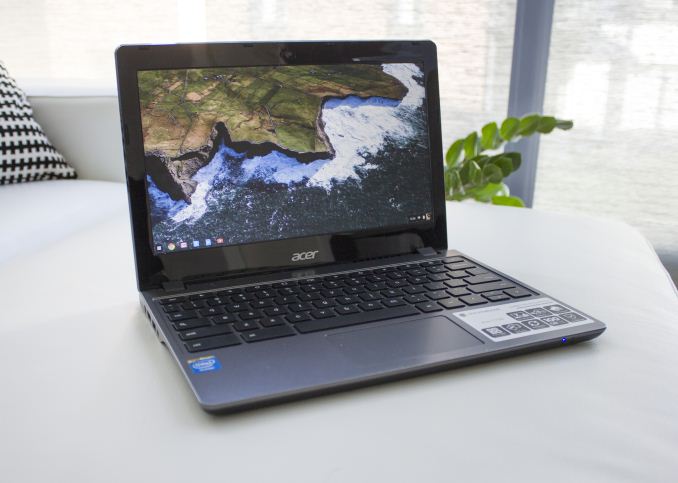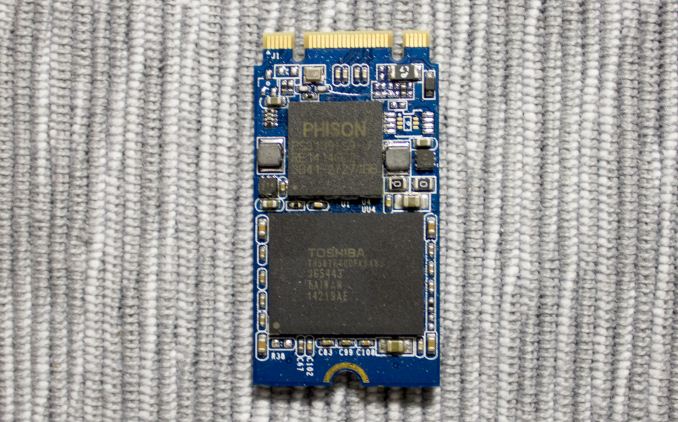Upgrading the SSD in Chromebook & MyDigitalSSD Super Boot Drive M.2 2242 SSD Review
by Kristian Vättö on October 21, 2014 8:00 AM EST
While the whole netbook boom kind of died with the introduction of tablets, Chromebooks have been gaining more and more traction recently. The original Windows netbooks failed to provide a smooth user experience due to the lack of operating system optimization, and Windows was simply way too heavy to be run with such limited resources. Chrome OS on the other hand was designed specifically for netbook-like devices. Google took a totally different approach by designing the Chrome OS around web and cloud-based services, which allowed the OS to be run with very little onboard storage.
Most of today's Chromebooks actually ship with either a small mSATA/M.2 SSD or have an eMMC package onboard, which is a bit ironic since Chromebooks are generally the cheapest laptops around, yet if you buy a Windows laptop that costs twice as much you will most likely end up with a traditional hard drive for storage. That is an enormous benefit that Chromebooks have because the lack of a hard drive enables much thinner and lighter designs, which translates into a better user experience.
The majority of the Chromebooks have 16GB of onboard storage with some high-end models having twice that. For the intended usage where everything is done in the web, that is sufficient, but when you need local storage for offline occasions (e.g. when traveling), 16GB or 32GB will not get you far. There is always the option of carrying external storage to expand the internal storage, but there is another alternative: upgrading the internal SSD.
For the purpose of this review, MyDigitalSSD sent us a 256GB Super Boot Drive in M.2 2242 form factor along with Acer's C720-2848 Chromebook.
| Acer C720-2848 Chromebook Specifications | |||||||||
| Display | 11.6" 1366x768 | ||||||||
| Processor | Intel Celeron 2955U (2/2, 1.4GHz, 2MB, 15W) | ||||||||
| Graphics | Intel HD Graphics (200MHz, 1GHz max Turbo) | ||||||||
| Memory | 2GB DDR3 | ||||||||
| Storage | 16GB SSD (M.2 2242) | ||||||||
| Connectivity | WiFi (802.11 a/b/g/n), Bluetooth 4.0, 1x USB 3.0, 1x USB 2.0, SD card reader, 1x HDMI | ||||||||
| Dimensions | 11.34" x 8.03" x 0.78" (W x D x H) | ||||||||
| Weight | 2.98lb | ||||||||
The C720 is what you would expect a Chromebook to be. The display is a bad TN panel, the trackpad does not always feel responsive, and the overall build is just plastic. It feels cheap, but the positive thing is that it really is cheap, as the C720-2848 currently retails for just $200. I cannot really give an objective review of the laptop itself as I have not used any other Chromebooks, but overall I am fairly impressed with what $200 gets you nowadays.
| MyDigitalSSD Super Boot Drive M.2 2242 Specifications | |||||||||
| Capacity | 8GB | 16GB | 32GB | 64GB | 128GB | 256GB | |||
| Controller | Phison S9 (PS3109) | ||||||||
| NAND | Toshiba A19nm MLC | ||||||||
| Sequential Read | Up to 545MB/s | ||||||||
| Sequential Write | Up to 410MB/s | ||||||||
| Warranty | Three years | ||||||||
Like other MyDigitalSSD's SSDs, the Super Boot Drive is based on a Phison controller and comes in a variety of capacities. The M.2 2242 currently tops out at 256GB since the form factor limits the number of NAND packages to two, and with 16GB die 128GB packages are the biggest that are available in the open market.
Notice that there is no DRAM at all. The M.2 2242 form factor lacks the space for a dedicated DRAM chip, so the NAND mapping table and host IO caching is done in the internal caches of the controller (usually a few megabytes of SRAM). There is a bit of a performance penalty from doing that as the internal caches are much smaller, but it is the only viable way to squeeze a full SSD into such small area.
Test Systems
There are two major items we want to look at in this review: first, we want to investigate the upgrade procedure for the Acer C720 Chromebook and examine Chrome OS performance, and second we're going to look at the MyDigitalSSD Super Boot Drive as a standard SSD and run our usual storage tests. For AnandTech Storage Benches, performance consistency, random and sequential performance, performance vs. transfer size and load power consumption we use the following system:
| CPU | Intel Core i5-2500K running at 3.3GHz (Turbo & EIST enabled) |
| Motherboard | ASRock Z68 Pro3 |
| Chipset | Intel Z68 |
| Chipset Drivers | Intel 9.1.1.1015 + Intel RST 10.2 |
| Memory | G.Skill RipjawsX DDR3-1600 4 x 8GB (9-9-9-24) |
| Video Card | Palit GeForce GTX 770 JetStream 2GB GDDR5 (1150MHz core clock; 3505MHz GDDR5 effective) |
| Video Drivers | NVIDIA GeForce 332.21 WHQL |
| Desktop Resolution | 1920 x 1080 |
| OS | Windows 7 x64 |
Thanks to G.Skill for the RipjawsX 32GB DDR3 DRAM kit
For slumber power testing we used a different system:
| CPU | Intel Core i7-4770K running at 3.3GHz (Turbo & EIST enabled, C-states disabled) |
| Motherboard | ASUS Z87 Deluxe (BIOS 1707) |
| Chipset | Intel Z87 |
| Chipset Drivers | Intel 9.4.0.1026 + Intel RST 12.9 |
| Memory | Corsair Vengeance DDR3-1866 2x8GB (9-10-9-27 2T) |
| Graphics | Intel HD Graphics 4600 |
| Graphics Drivers | 15.33.8.64.3345 |
| Desktop Resolution | 1920 x 1080 |
| OS | Windows 7 x64 |
- Thanks to Intel for the Core i7-4770K CPU
- Thanks to ASUS for the Z87 Deluxe motherboard
- Thanks to Corsair for the Vengeance 16GB DDR3-1866 DRAM kit, RM750 power supply, Hydro H60 CPU cooler and Carbide 330R case












67 Comments
View All Comments
abianand - Thursday, October 23, 2014 - link
Thank you...very stupid of me posing a question without reading the article fully. First time I've done that.Spending around 75-80 for an ssd upgrade negatively affects the value proposition of the chromebook, which in the first place is questionable (to my purpose)
AnnonymousCoward - Thursday, October 23, 2014 - link
5 pages talk about performance, yet there's no inkling on actual user performance. You say "the performance difference is tremendous" - back that up with boot time or app launch time! Just looking at synthetics is idiotic.Realtime power consumption is less meaningful than total power consumed for some task. Faster transfer rates use more power while it's transferring but operate for less time.
cutterjohn - Saturday, November 1, 2014 - link
Also remember AMD is AWFUL wrt power usage.I recently bought a C720/i3/4GB version and replaced the shipped SSD w/128GB my digital -> ~100GB available. I suspect that part of the SSD space is walled of for OS reasons as there is a factory restore(in Android parlance) option which means a clean copy is stored somewhere, probably on it's own partition, and part of the space is probably also saved as misc space(I forget what they call it for SSDs, spare?).
Anyways ATM I've also croutonized it w/ xfce/Ubuntu 14.04, there's also croagh which supports more distros, e.g. ARCH, and chrubuntu which just replaces chrome os IIRC(wasn't ready to do that and probably won't*.)
* I used chrome os exclusively for a few days(waiting for SSD delivery) and it was quite fast and power efficient, regularly giving me ~8h of runtime. It was able to play netflix & amazon instant video OOB, but I haven't tried again since dev moding it and croutonizing it. (I've seen comments that dev mode removes netflix streaming capability, but they were old.)
Even with chroot Ubuntu/xfce it's pretty quick. A fair number of steam games are available for it, and I've just recently installed wine, but have not gotten around to trying out and windows apps/games yet although there are some videos of even skyrim(low settings although the videographer claims medium does OK as well) running on a celery chromebook.
Personally, I'd like an even smaller chromebook, more in the original netbook form factor, in which case 1280x720 or the existing 1366x768 would be quite dense although cramping the keyboard. I mainly picked it up for size and batt runtime as even my Sager 7330 is a bit bulky at times(13") and batt runtime is usually only ~3h. I also wouldn't have minded an i5 option as well and slotted RAM...
omegajimes - Tuesday, November 4, 2014 - link
Do people actually use Chromebooks with ChromeOS? I thought the only reason to pick these up were to load lightweight linux distros like Mint or Elementary on them.leoku - Wednesday, November 5, 2014 - link
I think the Commodore C64 all-in-one in the great grandpa's era is more fun than these netbooks and chromebooks, plus you can program it right out of the box. A Commodore C64 is more expensive than Chromebook nowadays, though.leoku - Wednesday, November 5, 2014 - link
Given the fact, I think the SSD upgrade for a Chromebook is a waste of money.dareo - Sunday, November 30, 2014 - link
I’ve just ordered a Lenovo S540 and it comes with a 1 TB HDD (5400 rpm) + a 16 GB M.2 SSD for caching. This leads to several questions related to the MyDigitalSSD 128GB Super Boot Drive:1. Could I swap out the 16 GB M.2 that comes with the Lenovo, replace it with the MyDigitalSSD 128GB Super Boot Drive, install the OS and apps on it and use it as the primary boot drive?
2. What’s the difference between the MyDigitalSSD 128GB Super Boot Drive and the MyDigitalSSD SC2 Super Cache 2 42mm SATA III 6G M.2 NGFF M2 SSD Solid State Drive?
3. How reliable is this M.2 SSD in comparison to a Crucial MX100 or a Samsung EVO?
4. Would it just make more sense to pluck the M.2 and HHD from the computer and install a 500 GB Crucial MX100 or a Samsung EVO?
Thanks in advance for any feedback / advice on this.